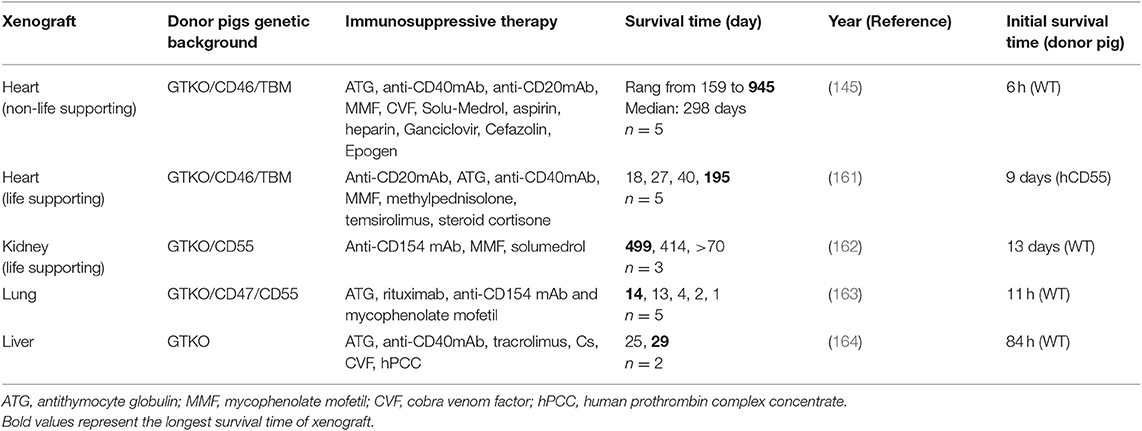Alternatives to Transplantation: Pig Organs and Mechanical Hearts
Written by: Jack Morby
Thousands of people are living with a severe cardiological issue and are waiting for a heart to be donated. Often, these people never receive a transplant operation and die waiting. Because of the large need for healthy donated organs, researchers have been working hard to come up with alternatives. An overwhelming amount of unique processes have been invented to address this problem, ranging from xenotransplantation to mechanical hearts. Researchers trying to solve the organ transplant shortage not only face a technological challenge but also an ethical debate. The novel operations like receiving a mechanical heart are not always safe, and there is sometimes considerable risk involved. Each method of heart transplant has varying potential for improving the condition of humankind, which makes them all worth pursuing and understanding further.
Xenotransplantation
The process of xenotransplantation, transplanting organs from animals into human bodies, is not a new concept. The transplantation has been practiced for the past century with optimistic results. Many independent experiments included the transplantation of organs from various species such as pigs, chimpanzees, and baboons. But, one of the largest problems with transplanting foreign matter into the human body is the reaction that could ensue. If the human immune system recognizes the new organ as foreign matter, it would target it with T-cells and antibodies which would cause damage. Most operations might be successful in the hours or days that follow the surgery, but is not effective in the long-term. This response poses a significant obstacle to the field. Luckily, because of genetic engineering and other methods, work is being done to overcome this response and trick the body into thinking the organ is not foreign material. As shown in the figure below, research in the field is not always done with humans because of the risks associated with the experimental nature of the operation. As an alternative, non-human primates are commonly used. Figure 1 is based on transplants of pig organs into non-human primates. The study was done to test the immune response of the primates and therefore gain better knowledge of a human’s immune response because of the similarity in physiology between primates.
Figure 1

A table depicting the best survival time of solid organ xenotransplantation from pigs to non-human primates.
Source: Lu, Tianyu
Mechanical Hearts
Another alternative that is being researched and utilized is a mechanical version of the heart, which is able to complete all of a heart’s functions. One of the most commonly used versions of the mechanical heart is the SynCardia Total Artificial Heart. Over 600 patients have been transplanted with SynCardia since 2010. This device is made of biocompatible plastic so as to avoid the immune response and is composed of two ventricles and four valves. It pumps blood by sending pulses of air to inflate the machine and push blood through your body and then also send pulses of vacuum to suck it in as well. A battery powered external driver can be worn in a purse-like bag to even be mobile with the device. The downside to this device is that it can only be used as a “bridge transplant” with the sole purpose of extending the patient’s life until they can transplant an actual human heart. However, despite not being the complete answer, it still is a massive step towards solving the problem.
Besides the SynCardia, there has also been research into machines that assist the existing heart in its functions instead of replacing it to prolong its effective lifespan. Shown in the figure below is one of these devices called a “cardiac sling.” The device applies pressure to the heart at the correct times by following the rhythm of the heart to help with the pumping of blood. Because it is just building off of the scaffolding of the natural organ it is much less intrusive compared to removing the organ and helps to decrease the chances of the body rejecting the device.
Figure 2

Drawing of a hypothetical “cardiac sling” powered by the MEC. On the left side of the figure, the wrap is allowed to open up as the ventricles fill. On the right, the MEC actuates a piston that closes the wrap around the heart, preferentially pulling the left wall.
Source: Trumble, Dennis
Conclusion
The advancements that will be made in the field of biomedical engineering have and will continue to change the future of medicine. The health-care industry is always finding new problems that need to be solved, often needing innovative solutions. As more people realize the potential of fascinating solutions like xenotransplantation and mechanical hearts, especially as they advance to being a long-term solution, more investments will be made into this technology and the probability of its success will increase. Serious attention to this field can lead to new heart-transplant methods that will help save thousands of lives.
References and Sources
Cooper, David K C. “A Brief History of Cross-Species Organ Transplantation.” Proceedings (Baylor University. Medical Center), Baylor Health Care System, Jan. 2012, www.ncbi.nlm.nih.gov/pmc/articles/PMC3246856/.
Khan, Sanna, and Waqas Jehangir. “Evolution of Artificial Hearts: An Overview and History.” Cardiology Research, Elmer Press, Oct. 2014, www.ncbi.nlm.nih.gov/pmc/articles/PMC5358116/.
Lu, Tianyu, et al. “Xenotransplantation: Current Status in Preclinical Research.” Frontiers, Frontiers, 1 Jan. 1AD, www.frontiersin.org/articles/10.3389/fimmu.2019.03060/full.
Okeke, Jonathan C., and Chris O. Akpan. “An Inquiry into the Moral Question of Xeno-Transplantation.” Online Journal of Health Ethics, vol. 8, 2012, doi:10.18785/ojhe.0801.02.
Trumble, Dennis R. “Potential Mechanisms for Muscle-Powered Cardiac Support.” Artificial Organs, vol. 35, no. 7, 2011, pp. 715–720., doi:10.1111/j.1525-1594.2010.01170.x.